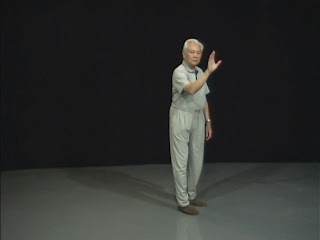Friday, December 24, 2021
How to connect arm to core
Sunday, December 19, 2021
The waist turns on a radius
Consider what Master Hwa is doing as the following paraphrase and analogy of his arm as "belt" moved from center. “Neijia” v. "Waijia” ; whether quarter, half, upper body turn: “It is known and practiced by all competent golfers, tennis players, etc. The strength and mass of the body is in its center, so it makes sense to begin and control motion at the waist. Consider this illustration. Hold one end of a long belt in one hand. Imagine that end to be the center of a circle, with a radius equal to the length of the belt. If you try to describe the periphery of the circle by using your other hand to move the free end of the belt, your efforts will be slow and awkward. However, if you leave one end to swing free, and merely flip the wrist of the hand holding the “center” end, the belt will swing around and around, smoothly and with great speed. Beginning at the center; returning to the center. Tai Chi is basically a conservative philosophy of motion. Conservative as in conservation. One of the priorities is simply to endure - energy flows in circles, always returning, never exhausted. This is a kind of thinking that we are beginning to understand as we foresee that in the future we may have exhausted the world’s once “inexhaustible” energy reserves. Tai Chi is also recycling of energy - and it demonstrates that for each of us our bodies can be a microcosm of the whole physical universe."
Sunday, December 12, 2021
Caveat Emptor re. Push Hands
Caveat of Push Hands a video link
Thursday, December 9, 2021
Understand the capability of "Dan Tien"
Understand the capability of Dan Tien
I don`t understand when using internal movement how do you keep your abdomen loose, or is that myth not true.(Maurice B.)
I am finding the Tai Chi Walk difficult probably due to my having to break old habits with the Yang Style. But it is coming along. The step backward is awkward in that I find it hard to keep my buttocks tightly in and pivot at the same time. (Jim D.)
Master Stephen Hwa: The sit back move requires you to fully tuck in the behind by energizing the abdomen and at the same time you have to be able to turn at the waist with ease and with power to ward off opponent' s attack (see Figure 9).
Figure 9
The above examples illustrate that the Dantian has to be able to do multitasking. One has to understand that energizing the Dantian for certain move is different from tensing up the Dantian. Tensing or stiffening the Dantian immobilizes the entire section of that part of the body indiscriminately. Energizing is a selective utilization of certain muscle for a certain function. Energizing has the character of agility, sudden surge and ebb not static.
Even "tuck in", also called "stretch down tailbone" should be fluid in nature. So, even one is fully tucked in, one should still have the feeling of suppleness (pronounced "soong" in Chinese) at the Dantian. A simple picture of what is going on during the sit back and ward off movements mentioned above could be as follows:
The tuck in move uses the Rectus Abdominis muscle, while the turning move uses the the External and Internal Obliques. Even though both muscles are next to each other in the same region, with the yin-yang training in tai chi, one should be able to use its distinctive feature independent of each other or in cooperation with each other. All those attributes mentioned above can be developed by practicing the Tai Chi Form. I have seen this among my students.
Tuesday, December 7, 2021
Why else a fist holding a Robin's egg?
Sifu Jim R: Here we are at the "World's best Tai Chi Studio". In light of Newton's 3rd law we know not to use "Ordinary force", aka external, muscle flexed, rigid, etc when we push. Here's refreshed information from Forum 10's discussion on the dan tien's energy/rigidity on not using Ordinary force. Here's how instead to use Fajin in "Peng/Ward off" when the concern is with the arm. Note that Master Hwa’s fist is not clenched, but the red shirt student’s fist is. Master Hwa maintains a small space in fist, like holding a “birds egg”, so now read why this is.
Would you feel it if it landed on you?
A Bumblebee cannot light or leave it A video Some folks, and some Tai Chi aficionados, say the precision of the Classical Tai Chi Square ...

-
Very interesting post! But my Taiwanese sources tell me, that Xiong Yanghe's Taijiquan has many origins, from some nephew of Yang Luch...
-
Yielding Sit Back Video Link When I “Take the opponent higher” I sit back but there is a “tilt”. I am in “sit back” and yielding” in respo...






